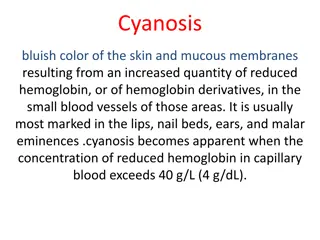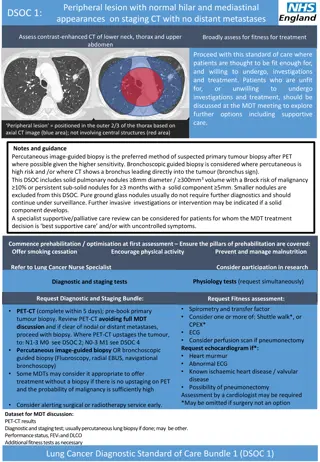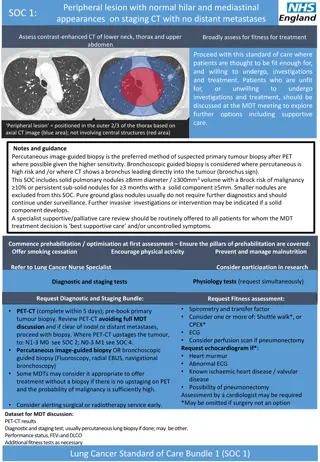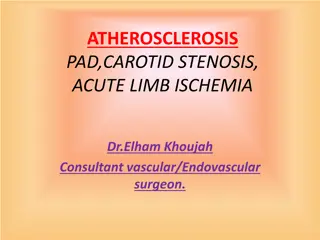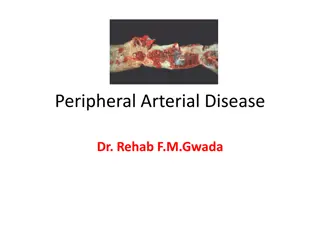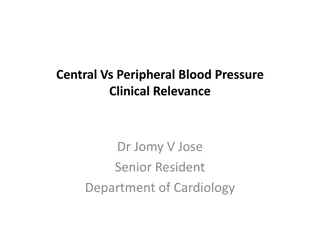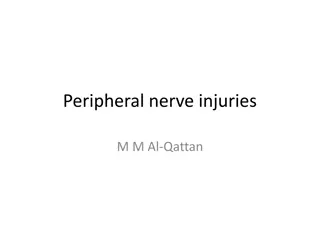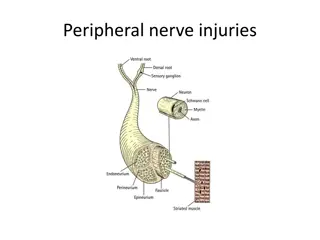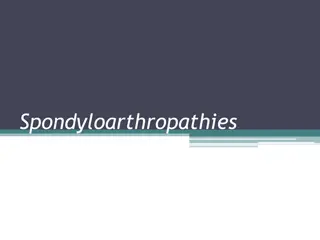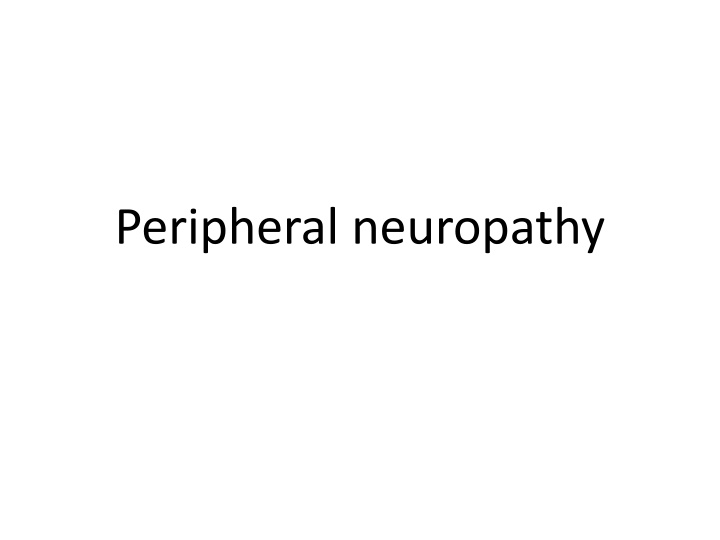
Peripheral Neuropathy: Types and Causes
Peripheral neuropathy (PNP) refers to nerve damage in the peripheral nervous system. This condition can be characterized based on the number of nerves affected and the fiber type injured. Mononeuropathy affects a single nerve, while polyneuropathies involve many nerves. Causes of PNP include diabetes mellitus, autoimmune diseases, and infections. Recognizing the type of neuropathy and its underlying cause is essential for proper management.
Download Presentation

Please find below an Image/Link to download the presentation.
The content on the website is provided AS IS for your information and personal use only. It may not be sold, licensed, or shared on other websites without obtaining consent from the author. If you encounter any issues during the download, it is possible that the publisher has removed the file from their server.
You are allowed to download the files provided on this website for personal or commercial use, subject to the condition that they are used lawfully. All files are the property of their respective owners.
The content on the website is provided AS IS for your information and personal use only. It may not be sold, licensed, or shared on other websites without obtaining consent from the author.
E N D
Presentation Transcript
Peripheral neuropathy(PNP) refers to damage to nerves of the peripheral nervous system, Types of Peripheral Neuropathies There are many ways to characterize peripheral neuropathy:
First the number of nerves that are affected: Mononeuropathy is a type of neuropathy that only affects a single nerve. The most common cause is by physical compression of the nerve, known as compression neuropathy. Carpal tunnel syndrome is one example of this. Direct injury to a nerve, interruption of its blood supply (ischemia), or inflammation can also cause mononeuropathy.
Mononeuritis multiplex is simultaneous or sequential involvement of individual noncontiguous nerve trunks, either partially or completely. It usually evolving over days to years and typically presents with acute or subacute loss of sensory and motor function of individual nerves. The pattern of involvement is asymmetric; however, as the disease progresses deficit(s) becomes more confluent and symmetrical, making it difficult to differentiate from polyneuropathy. Therefore, attention to the pattern of early symptoms is important.
It is caused by, or associated with, several medical conditions: diabetes mellitus vasculitides: polyarteritis nodosa, Wegener's granulomatosis, and Churg Strauss syndrome immune-mediated diseases like rheumatoid arthritis, lupus erythematosus (SLE), and sarcoidosis infections: leprosy, lyme disease, HIV
Polyneuropathies involve many nerves, often symmetrically so that both feet or hands are affected. Polyneuropathies can be axonal, which are injuries to the nerve itself, or demyelinating, which are injuries to the protective myelin sheath, or mixed, involving both types of injuries.
A second way to classify neuropathies is by the fiber type that is injured. There are three types of fibers: Sensory - sensory neuropathies cause abnormal sensations such as pain, cold, heat or burning sensations, tingling, or numbness. Motor - may result in weakness and wasting Autonomic - can cause decreased perspiration, bowel and bladder problems, and sexual dysfunction.
The size of fiber is also a determining factor in the type of neuropathy: Small fiber neuropathy can cause decreased sensation to pinpricks or temperature; discomfort or burning sensation in lower extremities; autonomic problems with bowel, bladder, or sweating abnormalities; but usually does not affect strength, motor function, and balance.
Large fiber neuropathy result in loss of reflexes and motor dysfunction such as weakness, unsteadiness, and balance problems.
Causes of peripheral neuropathy Alcoholism cause peripheral neuropathy because of poor dietary choices, leading to vitamin deficiencies. Autoimmune diseases. These include: lupus, rheumatoid arthritis and Guillain-Barre syndrome. Diabetes. At least half of patients with diabetes develop some type of neuropathy.
Exposure to poisons. toxic substances: such as heavy metals. certain medications: especially chemotherapy. Infections. Lyme disease, shingles (varicella-zoster), Epstein- Barr, hepatitis C and HIV.
Inherited disorders. Charcot-Marie-Tooth disease and amyloid polyneuropathy. Trauma or pressure on the nerve. Traumas: such as falls or sports injuries, can damage peripheral nerves. Nerve pressure : using a cast or crutches, spending a long time in an unnatural position or repeating a motion many times such as typing. Tumors. Growths can form directly on the nerves themselves, or tumors can exert pressure on surrounding nerves.
Vitamin deficiencies. B vitamins B-1, B-6 and B-12 Vitamin E and niacin also are crucial to nerve health. Other diseases. Kidney disease, liver disease and hypothyroidism also can cause peripheral neuropathy.
Neuropathy Symptoms Regardless of the cause, neuropathy is associated with characteristic symptoms. in peripheral neuropathy, Symptoms often begin in the feet with a gradual onset of loss of feeling, numbness, tingling, or pain and progress toward the center of the body with time. The arms or legs may be involved. The inability to determine joint position may also occur, which can result in clumsiness or falls. Extreme sensitivity to touch can be another symptom of peripheral neuropathy. The sensation of numbness and tingling of the skin is medically known as paresthesia.
The loss of sensory input from the foot means that blisters and sores on the feet may develop rapidly and not be noticed. Because there is a reduced sensation of pain, these sores may become infected and the infection may spread to deeper tissues. When damage to the motor nerves (those that control movement) occurs, symptoms include weakness, loss of reflexes, loss of muscle mass and cramping.
Autonomic neuropathy, may manifest with a wide variety of symptoms, including: Nausea, vomiting, or abdominal bloating after meals Urinary symptoms, such as incontinence, difficulty beginning to urinate, or feeling that the bladder was not completely emptied Impotence Dizziness or fainting Constipation or diarrhea
Diagnosis Diagnosis usually requires: A full medical history. This includes symptoms, lifestyle, exposure to toxins, drinking habits and a family history of neurological disease. Neurological exam. This may include checking tendon reflexes, muscle strength and tone, ability to feel certain sensations, and posture and coordination. General exam. do a complete physical exam.
Tests, including: Blood tests. These measure various levels, such as vitamin and blood sugar ; and bodily functions, such, liver and kidney. Nerve function tests. These may include EMG which reads electrical activity in the muscles to determine if weakness is caused by muscle damage or nerve damage and NCT which assess how the nerves and muscles respond to small electrical stimuli, generated by a probe and measured by an electrode placed along the nerve's pathway. Nerve biopsy. This procedure may determine the pathological changes, damaging the periperal nerves. Imaging tests. CT scan or MRI to look for herniated disks, tumors or other abnormalities.
Neuropathy Treatment Treatment of the undrerlying cause Medical treatments for diabetes, autoimmune diseases, infections, kidney disease, and vitamin deficiencies. In many cases, treatment of the underlying disease can reduce or eliminate the symptoms of neuropathy. Some cases, especially those involving compression or entrapment of nerves by tumors or other conditions, can be relieved by surgery.
Symptomatic treatment over-the-counter drugs such as acetaminophen and ibuprofen are not generally effective for controlling the pain of neuropathy.
Oral medications that have been successfully used to help the pain of neuropathy include: Antidepressants: Antidepressants including the tricyclic antidepressants amitriptyline , imipramine, and desipramine as well as other antidepressants such as paroxetine , and citalopram . Anticonvulsants: Anticonvulsantssuchas gabapen tin(Neurontin), carbamazepine ( Tegretol), and lamotrigine (Lamictal). Opioids and opioid-like drugs such as controlled- release oxycodone and tramadol
Topical medications that may bring pain relief include capsaicin cream and lidocaine patches.






